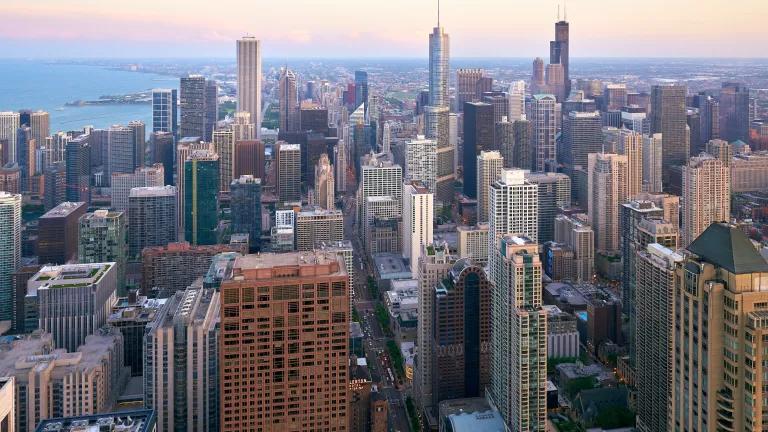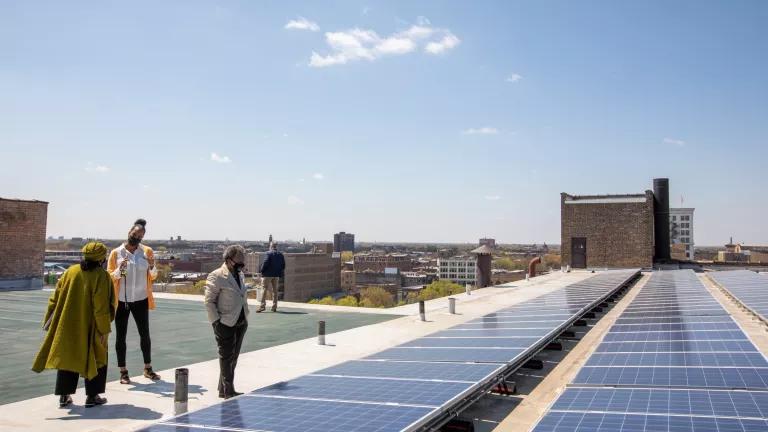Better Energy Options for Chicago: Clean and Affordable Buildings
A thoughtful transition toward clean and affordable buildings would help reduce high energy bills and indoor air pollution harming Chicago residents.

Energy used in Chicago's buildings account for 70 percent of the City's greenhouse gas emissions.
Pedro Szekely via Flicker, CC BY-SA 2.0.
The vast majority of Chicago’s buildings rely on burning expensive, polluting “natural” gas for energy needs like heating and cooking. But gas is increasingly unaffordable, increasingly unreliable in extreme weather, and not safe for our health or our climate. Continued reliance on gas puts Chicagoans at risk for high energy bills and indoor air pollution. It’s time for Chicago to provide affordable, efficient, and healthier alternatives through policies that support clean buildings.
Let’s dig into what Chicago could gain by replacing outdated, inefficient fossil fuel technology with modern electric appliances. The benefits of cleaner and more affordable buildings are too good to pass up.
Energy savings and affordable heat
Heating bills for the Chicago area have increased each of the past two winters. Proposed record rate hikes by utilities like Peoples Gas would exacerbate the already high energy costs disproportionately burdening low-income and Black households in Chicago. Chicago residents are being squeezed by skyrocketing gas bills and need a way out.
Clean and affordable homes and buildings can save Chicagoans money by avoiding costly gas and gas infrastructure and because today's electric appliances use so little energy compared to gas-fired ones. Burning fossil fuels inside your kitchen or your furnace wastes energy—and money—compared to appliances powered by electricity. Modern heat pumps, which provide both heating and cooling, are so energy efficient that they can use as little as a third of the energy of a gas furnace. Heat pump water heaters use a tenth the energy of a gas water heater. Modern induction cooktops are three times more efficient than gas stoves.
Switching from gas to electricity for household energy needs has the potential for significant cost savings. In 2018, analysis by RMI found that when constructing new buildings in Chicago, heat pumps were significantly more cost-effective than installing air conditioning and a gas furnace and water heater. In 2021, Citizens Utility Board found that replacing a gas furnace with a heat pump in Chicago could create lifetime savings between $24,716 and $47,104 through 2055. Thanks to the cost savings, heat pumps pay for themselves in as little as three years.
A 2022 NRDC report added to the pile of evidence that Chicago households could save by using electric appliances instead of gas. And the more electric you go, the more you can save. The analysis found that a household living in a newly constructed all-electric building in Chicago with forced air heating would save between $15,000 and $31,000 on energy costs over twenty years compared to a new home powered by gas, depending on whether federal incentives are applied and whether the building is a single family or multi family home. NRDC’s analysis also found that fully replacing gas appliances and electrifying an existing home would save between $10,000 and $24,000 over 20 years, again depending on the type of home and federal rebates.
Ditching gas and ditching polluted indoor air
When we think about air pollution in Chicago, we often think about emissions from power plants or diesel trucks (or wildfires) and their dangerous health effects. Our homes should be a safe place to breathe easily, and we shouldn’t have to worry about toxins and pollutants inside our homes. But burning gas in our homes and buildings is a well-documented and inequitable health threat, especially for children and people of color, associated with increases in respiratory diseases like asthma as well as cancer.
Families that use electric appliances have safer homes without dangerous contaminants that come from burning gas. Replacing gas appliances with electric appliances has been found by researchers to improve indoor and outdoor air quality and reduce premature deaths, creating healthier air to breathe for both residents and neighbors by avoiding toxic fumes from gas stoves, furnaces, and water heaters.
A key step in reducing emissions and optimizing building electrification is weatherization. Energy efficiency improvements to homes provides important health, cost, and comfort benefits for residents. Energy efficiency upgrades not only reduce the amount of fossil fuels required to meet energy needs, improving air quality and lowering costs, but also make homes more comfortable and safe. More energy efficient buildings improve environmental conditions, reducing occupant health issues related to mold, asthma, and uncomfortable temperatures, and even the stress of high bills.
As the power grid gets cleaner, clean buildings cut emissions
Putting Chicago on the path toward cleaner, all-electric buildings will help reduce the emissions that harm community health, worsen climate change, and create environmental injustices. As Illinois’ power grid becomes more renewable, buildings that rely on electricity to meet energy needs mean less fossil fuel pollution.
Due to the growth of renewable electricity, a 2020 analysis by RMI and Elevate found that single-family homes in Illinois that use heat pumps for water and space heating would have a lower carbon footprint compared with high efficiency gas appliances or propane—even without methane leaks in the gas distribution system. A 2022 NRDC analysis also found that electrifying single or multi-family homes in Chicago with forced air heating would at least halve emissions over the next two decades compared to sticking with gas due to the cleaner trajectory of our electricity grid—and even cuts emissions as much as 30 percent in just the first year alone.
Clean buildings can shore up the grid
As buildings shift from gas to electricity, our power grid will need to provide more electricity. That’s why grid operators are constantly planning for the future and shifts in demand. But rather than adding stress to the grid, building electrification can strengthen the power system. Unlike old furnaces, smart, efficient appliances like heat pumps can support grid flexibility and respond to the needs of the power grid, enhancing grid reliability.
The power grid has run into problems during extreme weather, mostly due to fossil fuel power plant outages and relying too heavily on gas. Gas distribution systems also struggle in extreme winter weather due to gas production and supply troubles. When the grid is in a pinch and supplies of fossil fuels are frozen or undeliverable, using much more efficient appliances that require less energy helps. So does reducing our reliance on gas overall.
Clean and Affordable Buildings policies offer better energy options for Chicago
Cities and states across the country are already taking steps to address emissions from new and existing buildings. Chicago can pass policies that would help shift homes and buildings away from relying on gas for household energy needs over time. These policies would work by ensuring newly constructed buildings don’t expand our city’s gas infrastructure, which has been ballooning in cost, and by improving the energy efficiency of existing larger buildings and swapping out gas for electric appliances over time. Enacting clean and affordable buildings policies in Chicago would support clean energy and electrification jobs, help improve the air quality inside homes and buildings, and help lower energy costs.
Chicagoans deserve energy choices beyond Peoples Gas. Shifting away from inefficient, expensive, gas appliances to efficient all-electric buildings will save Chicagoans energy and money—while protecting their health from indoor air pollutants like cancer-causing benzene and asthma-aggravating nitrogen dioxide. It’s time for Chicago to act on Clean and Affordable Buildings.



